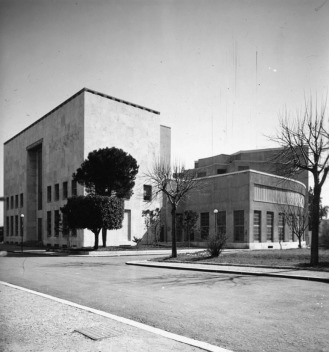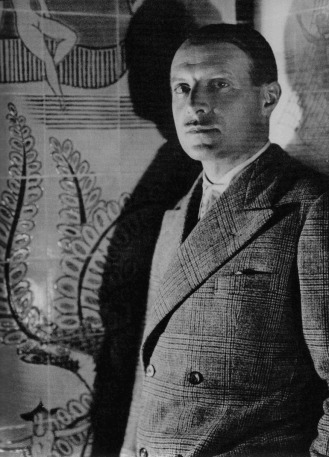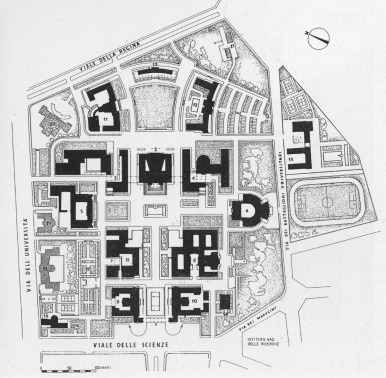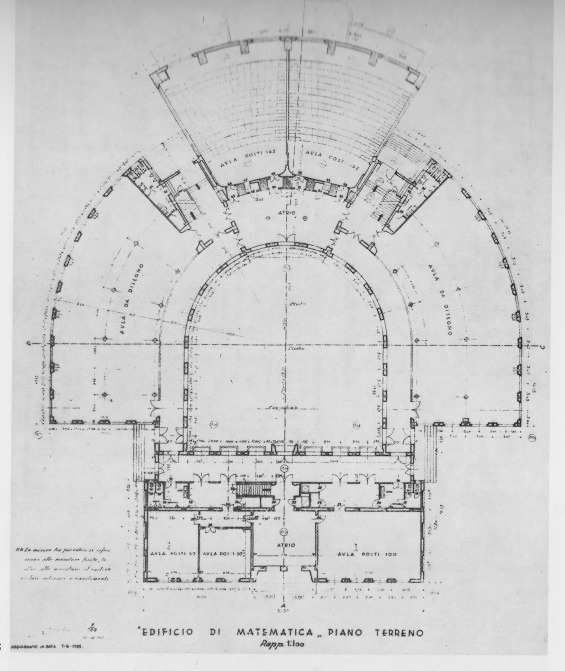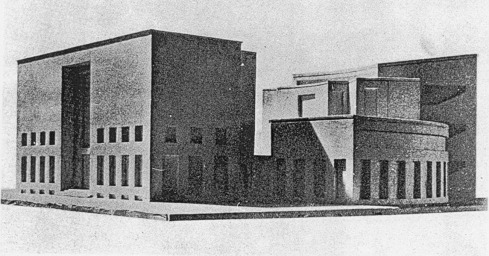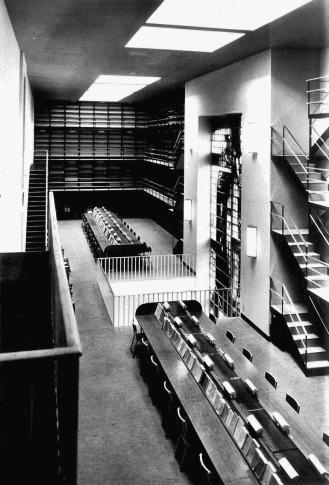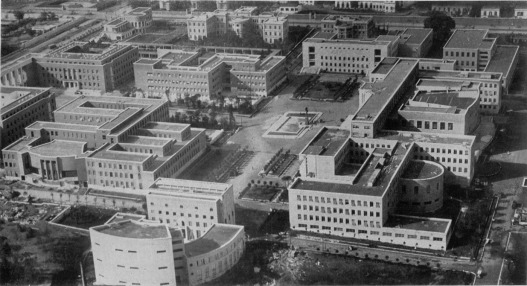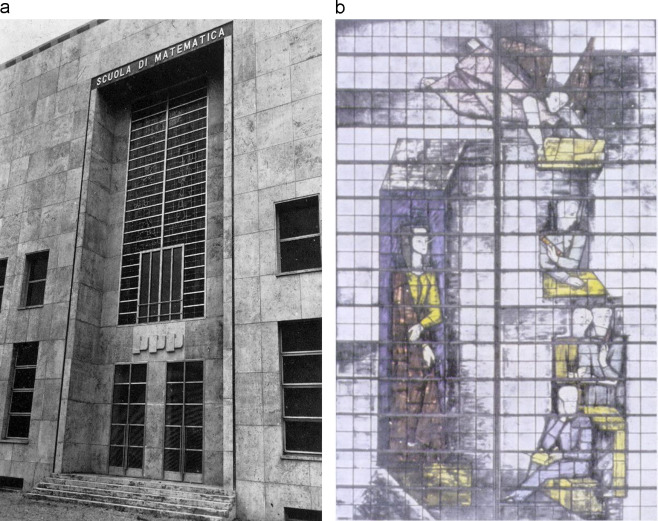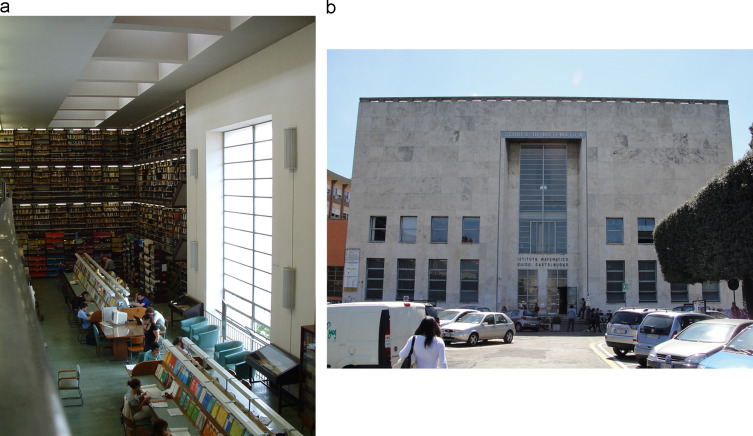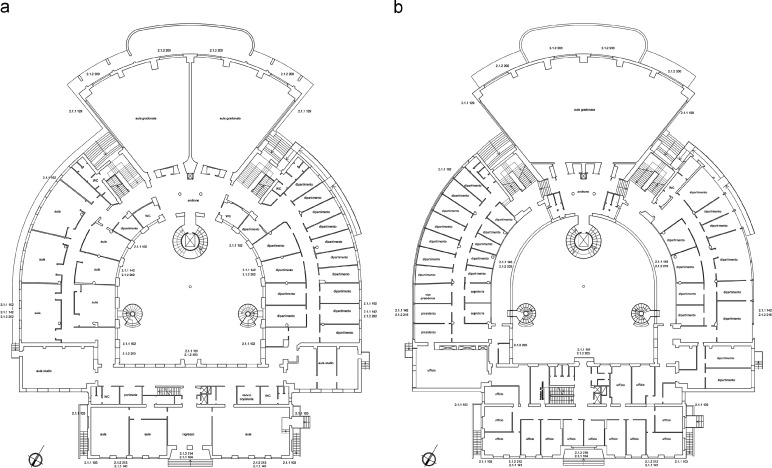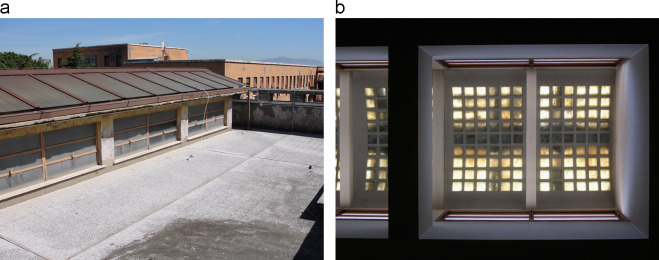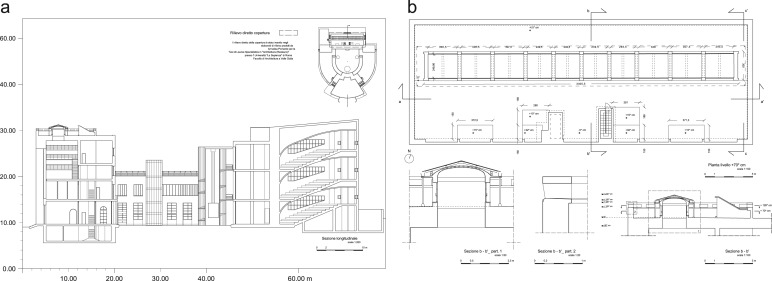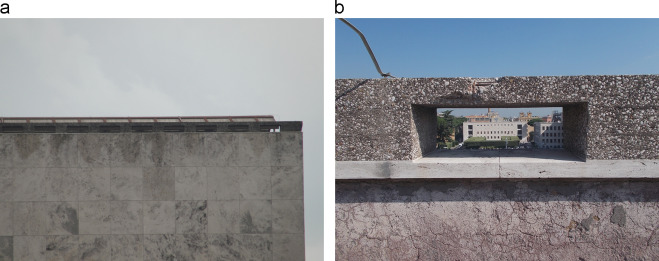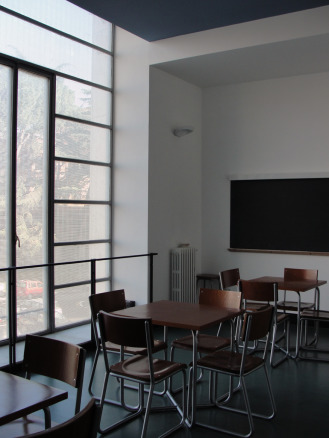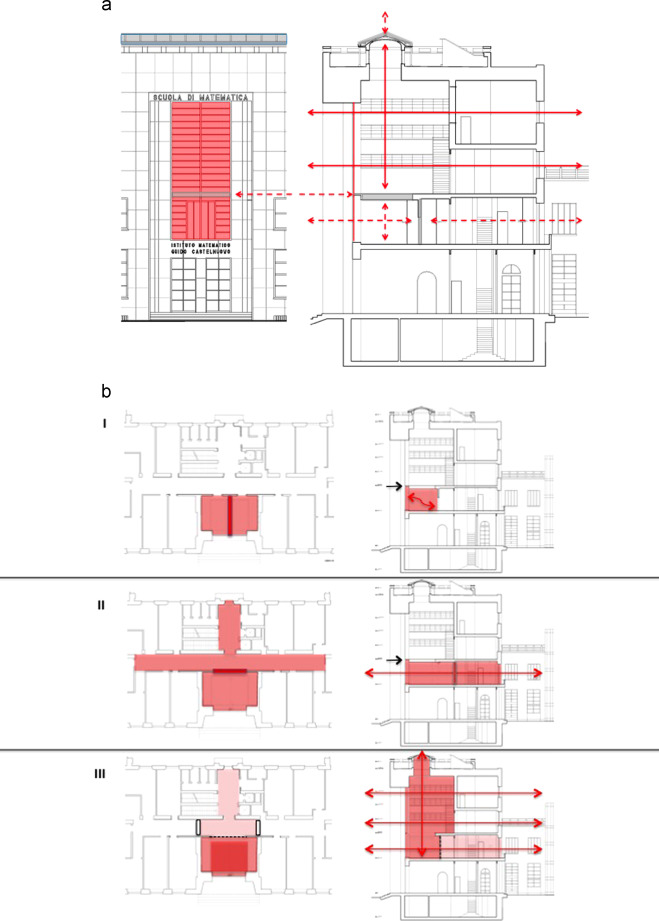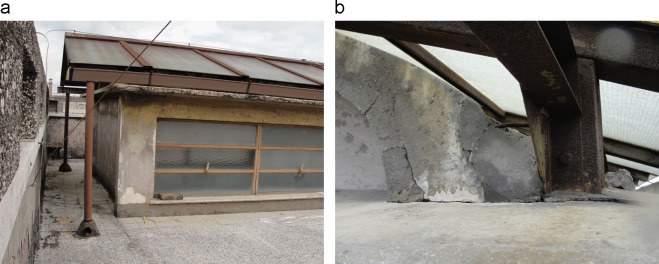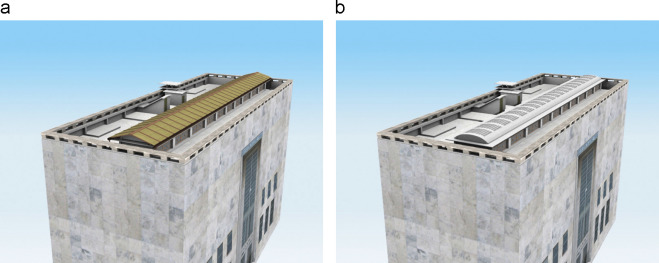Abstract
The framework of the Italian restoration doctrine is based on the reception and transmission of the memory of the past. However, interventions in modern architecture represent a radical drift in the sense that they mostly consist of reconstructions, refurbishments, and renovations. Such work disregards the sense of value acknowledgment that is implicit in architectural conservation and neglects the importance of material conservation. The uneven fortune of the School of Mathematics at Rome׳s University Campus illustrates this situation. This predicament is similar to that of many other modern buildings that have been declared “monuments” by mouth but are actually bent to listless and insensible use, mistreated, and hardly maintained. The recent work carried out at the School of Mathematics proves that interventions on modern buildings are mostly insensitive to their true significance and are often carried out in extreme urgency for mere practical reasons, if not for political opportunities.
Modern buildings can be true architectural monuments that express great esthetic potentials and retain notable historical weight in the history of architecture; therefore, they should be regarded as highly representative of our recent past and maintained as such.
Keywords
Conservation ; Restoration ; Modern architecture
“We only have our civilization to save our civilization.” (G. Ponti, 1943)
1. Modern architecture and Italian restoration culture
Within the Italian cultural context, restoration may be defined as an activity aimed at the reception and transmission of the memory of the past and applied to different artistic expressions. The development of a conservative approach within the European culture lasted for centuries. Such conservative approach acquired its “modern” shape between the 19th and 20th centuries and continues today, as indicated in the structures of Western civilization, in its culture, and in its environment. Therefore, restoration is about cultural demand and does not depend on the objects themselves. Despite the various interpretations to which conservation principles and methodology necessarily yield in practice, the main concepts do not change: neither in reference to a specific chronological context (whether an archeological ruin, an ancient monument, or a modern building) nor according to different figurative expressions (whether painting, sculpture, or architecture nor, in the latter case, in relation to the function of the building, its typology, its author, and so on). Hence, the specificity of this matter lies in the acknowledgment of the value of the object. This critical process should be driven by the sincere intention to conserve an artifact for its memory value.
Conservation may however meet very different declinations, which in turn become the “cultural mirror” of the civilizationthat expresses them, and should thus be considered strongly representative of the European culture and, in general, the Western one.
Given these premises, the practice in modern architectural heritage in the last three decades, has instead shown the rise of a retrospective approach and a consistent drift from the general restoration doctrine (Salvo, 2007a ).
The problem of conserving modern architecture, which was first proposed in Northern Europe in the early eighties, initially took shape as a reaction to the ramshackle conditions of many modernist “icons.” These buildings began to be appreciated after the post-war years for their appealing image and material novelty; thus, most of them have been restored to their original condition, assuming their “pure” form as their highest value.
Different from the so-called architectural “icons” of the 20th century, the coeval “built heritage,” such as housing estates, services, and civic buildings, has been subjected to interventions regardless of its historic and cultural value. Such work includes systematic refurbishment, retrofitting, reuse, reestablishment of efficiency and functionality, uninformed maintenance, and sometimes abandonment. This situation mirrors the fact that the built heritage of the past century is rather compelled to pander various concerns (e.g., cultural, symbolic, political, ideological, functional, economical) that all refer to current demands and not to what the object actually is or represents. In this sense, the abovementioned retrospective approach may be interpreted as a consequence of the “faintness” of our civilization, which tends to hold back the “icons” of the recent past without accepting its memory value. In the case of the broader built heritage, pragmatic and economic needs are favored rather than cultural ones. This condition has strongly limited the true value acknowledgment of recent architectural heritage and thus debases the importance of its material preservation as well as endorses its reconstruction instead of its conservation.
The maître à'penser in this specific field are practicing architects, designers, and technologists and not specialists in restoration, as would be more appropriate. The former are, in fact, still directly connected to modernity and perceive it as part of their genealogy or personal identity. Therefore, they avoid any historical intercession and their behavior is diametrically opposed to that of a conservation architect.
The retrospective attitude has been justified with the assumption that the physical substance of modern architecture rejects any kind of material conservation, thus claiming a different and ad hoc theoretical and methodological status for this field. The idea that conservation applies to the appearance of an artifact and not to its physical substance, which is rather stale if one considers the Italian restoration culture, has paved the way to new forms of “period reconstructions” based on very appealing philological references, such as original drawings, period photographs, direct testimonies, and sometimes, the support of the author himself. But philology is a serious matter that refers to the historical comprehension of a work of art and has nothing to do with mere reconstruction.
However, the process of value assessment is harshly hindered if the object is a recent one because of the absence of a chronological gap and consolidated historiography. When it comes to modern buildings, restoration principles and practices are truly put to test and require very fine critical skills to face unprecedented situations and explore new fields. Actually, restoration practice often meets such holdbacks, as in the case of the conservation of exceptional artworks, such as the Last Supper by Leonardo da Vinci, which represent the epitome of technical difficulties.
Therefore, the true challenge is not in outlining a new restoration theory or finding the solution to technical issues. Instead, it addresses the culture of memory itself and more specifically, the survival of the memory of Modernity.
While the international situation appears to be rather homogeneously oriented toward reconstruction1 , in Italy (at least theoretically) the situation holds onto the traditional scientific and critical theoretical framework and depends on long-lasting experience, which allows ultimate cases to be faced without derailing from conservative scopes. The restoration of the curtain wall facades of the Pirelli building in Milan (Gio Ponti׳s masterpiece dating back to 1960) presents a significant example of a true and successful conservation work applied to a very recent building (Salvo, 2007b ). Focused on the conservation of the physical matter (the original curtain wall system), this work has been tackled as a critical process based on scientific knowledge and technical understanding of the artifact and has been carried out in full respect of material authenticity. Overcoming considerable practical difficulties caused by the very modern construction technique and materials (anodized aluminum, glass, rubber, and plastic), the process has been acknowledged as traditional restoration work and thus provides exceptional outcomes and success.
However, this positive experience does not assure the fate of every other work by the same author, especially those dating back to the first half of the 20th century2 . These projects are somehow still considered to be related to the fascist ideology of the epoch and have often been dismissed for such reason and burdened by tentative oblivion, by hyper use and by reckless maintenance. Furthermore, in most cases, these buildings are destined for public use (schools, hospitals, post offices, and public residential estates) and are thus essential to everyday life. Lastly, given the abundance of archeological ruins, medieval basilicas, renaissance palazzos, and baroque churches in the “Eternal City,” modern buildings struggle to contend for their right to be considered “monuments.”
The horizon of this field is therefore marked with contrasts and oppositions that encumber complicated and hardworking practices but are thrilling and gratifying at the same time. Hence, although many modern buildings express great esthetic potentials and represent high historical value and should thus be kept as highly representative of our recent past, they are formally declared monuments without solid value acknowledgment, and are therefore subject to listless and insensible use.
This paper presents the results of a research conducted between 2010 and 20133 upon the School of Mathematics in Rome׳s University campus in the margins of a sporadic occasion offered by the Department of Mathematics that soon faded away as the conditions that had supported it changed. In 2013, the technical office of Sapienza University has conducted without consulting the results of our research.
2. School of Mathematics: A modern monument
Acknowledged by scholars and architects as one of the most relevant and beautiful Italian buildings of the first half of the last century, Rome׳s School of Mathematics is one of Ponti׳s least considered works and among the least investigated4 [ Figure 1 ]. This fact provides evidence on the difficult historical-critical positioning of Ponti׳s early works based on his unclear cultural role in this epoch marked by the rise of the fascist regime. On one hand, his work has been much appreciated, and his modern industrial-design objects are considered a cult. On the other hand, his buildings established in previous years have been long ignored, especially the Montecatini building (1936), which was the first to give him international fame. These projects have been reconsidered only recently and in some cases, recent conservation work has entailed a deeper understanding of Ponti׳s production. In addition, the 1930s have represented a “hard core” for Italian architectural historiography, which has long been oriented by a political and ideological interpretation of the buildings designed and under the fascist regime. A true revision of such position has been set out only recently on behalf of the wider chronological gap that separates today׳s scholars from that epoch. This condition allows for a more detached and objective judgment. Within this ongoing process, Ponti׳s figure and work are regaining a foreground role5 .
|
|
|
Figure 1. The building in the early fifties. |
Gio Ponti6 obtained the title of “Civil Architect” at Milan׳s Polytechnic in 1919, although he cultivated strong passion for painting. After an intense apprenticeship in industrial design, to which he dedicated his entire life, Ponti began to collaborate with important firms that produced household objects during the 1920s and 1930s. Ponti became the creative director of Fontana Arte, which is the main producer of artistic glass windows. Glass windows held a very important decorative role in many of Ponti׳s works of those years, including the School of Mathematics [ Figure 2 ].
|
|
|
Figure 2. Gio Ponti in 1931. |
In 1926, Ponti began working with Mino Fiocchi and Emilio Lancia. They committed to many projects, which were mainly residential buildings and mostly located in Milan. These domus or typical houses for the high-ranking Milanese middle-class, represented the focus of Ponti׳s architectural research in the pre-war years, embodying the idea of dwelling as a means to express the esthetic, social, and cultural roles of architecture.
The task to design the School of Mathematics, which was very different in terms of type and client, came in 1932 and engaged Ponti for three years.
In 1933, Ponti collaborated with Eugenio Soncini and Antonio Fornaroli. Together, they designed and built other typical houses and important buildings, such as the Faculty of Liberal Arts and the Rectorate of the University of Padua. However, the most important appointment was offered to Ponti in 1936 by a leading figure in the Italian industry, Guido Donegani, who entrusted him the prestigious project for the new headquarters of the Montecatini firm in Milan.
In the 1930s, Ponti׳s activity branched out into various fields. He founded the architectural review “Domus” in 1928 and directed it until his death in 1979. Between 1941 and 1947, he dedicated himself to the creation of “Stile,” another review dedicated to architecture, industrial design, and artistic culture. In those years, he was entrusted with various commitments and designed the costumes for Teatro alla Scala in Milan. Ponti became a tenured professor of Interior Design in 1936 and occupied this position until his retirement in 1961.
During these years, Ponti stood out not only for his artistic and architectural production but also for the broader cultural activity he developed with extraordinary steadiness and in coherence with the greatest industrial development ever experienced in Italy and the rest of Europe. Such qualities originated from strong artistic sensibility, notable intellectual skills, and profound religious faith. Ponti׳s character was marked by incurable optimism, freedom from partisanship and sectarianism, and absence of prejudices. Ignazio Gardella called him as follows:
“an open man, with an exuberant vitality, generous towards others, especially towards the young … With Ponti you would never feel the generation gap and I remember him as a dear friend who has left to me a great lesson of love for architecture … Beyond the sense of friendship, I believe Gio Ponti׳s great amount of works (achieved or left on paper) should be reconsidered in a historical perspective in order to place under the correct light the profile of an architect who has played an important role in Italian architectural culture of the century that is about to end” (Arditi and Serratto, 1994, p. VII ).
Ponti had full trust in industrial progress and firmly believed that the future can only be better than the past. He was spontaneously open to any form of artistic collaboration, was interactive by nature, and promoted true cultural osmosis. The pages of “Domus” and “Stile” still clearly serve as a venue where intellectuals meet to exchange ideas freely.
These years also coincided with the rise and affirmation of the fascist regime in Italy7 . Ponti initially shared the initiatives of the regime. He joined the Fascist Union of the Architects and became a member of its National Council in 1933 and of the Commission for the "Littoriali di Architettura" in 1936, a national competition showcasing the best design achievements of young Italian architects. He therefore participated and contributed to the entry of the fascist ideology into Italian culture but kept a political and a cultural distance from it by staying out of the polemics of traditionalists and rationalists and by adopting an independent architectural language marked by classical themes, a style that Edoardo Persico sharply defined as “Mediterranean” (Persico, 1934 ).
3. Urban context
The building of Rome׳s university campus, between 1930 and 1935, represented a complicated and problematic process that was deeply intertwined with Italian history8 . Many cultural transformations took place at that time, particularly in the architectural profession, higher teaching, and urban layout of the main Italian cities, especially Rome.
Mussolini tasked Marcello Piacentini with the overall design and management of the operation and entrusted him with technical, political, administrative, and economical aspects. Aligned with the political and cultural program of the dictator, who intended to revive the splendor of ancient Rome through the fascist ideology, Piacentini proposed a regular and symmetric urban layout. The design was based on a Latin-cross plan, with a main central alley cut by a perpendicular axis. The plan perfectly fit the rectangular area selected for the settlement, which was adjacent to the university policlinic and of public property [ Figure 3 ].
|
|
|
Figure 3. Plan for Rome University campus according to Piacentini׳s program (Architettura, 1935). |
Piacentini kept for himself the commitment of the urban layout and of the Rectorate building. He tasked 10 young architects9 with the design of the other buildings displayed along the main axes. Piacentini also entrusted to Gio Ponti the project of the School of Mathematics, which was to be placed in a very notable position at the head of the transversal axis. The reason for Piacentini׳s choice resulted in various historical interpretations because Ponti was different from his colleagues. He represented a rather independent fringe of the architectural culture of those times. However, Piacentini and Ponti shared a professional relation, a personal friendship, and mutual esteem. Perhaps Ponti was also appreciated for being the editor of “Domus” and for being well related to the Milanese industrial class (Barucci, 2002 ).
Ponti received a formal commitment on July 1932, but Piacentini pretended all the drawings were ready by September of the same year. The construction began in February 1934, but Ponti continued working even beyond the inauguration of the campus in October 1935 and remained busy with the definition of architectural and constructive details. This situation may explain why none of the original drawings conserved in archives10 or published in the reviews of the time correspond in detail to the building [ Figure 4 ].
|
|
|
Figure 4. Plan of the ground floor of the School of Mathematics in one of Ponti׳s original drawings (ASSUR, Patrimonio Edilizio, 1935). |
The project for the School of Mathematics was based on precise requirements in terms of space and distribution. Ponti developed the layout after consulting the eldest and youngest mathematicians of the Academy, namely, Guido Castelnuovo and Enrico Bompiani. Ponti provided four drawing halls, many medium-sized inclined classrooms (with 162 and 450 seats), classrooms with 50 or 100 seats, a library, offices for faculty members, a boardroom, and an inner court.
Although many architectural features of the campus, such as the selected materials and construction techniques, the modern architectural elements, and the essential character of the outer surfaces were enforced by Piacentini, Ponti retained a certain freedom of expression as his building resulted in a complicated structure when compared with the abstract forms of other ones (Melis, 1936 )11 . From the very first drawings, Ponti׳s project consisted of three juxtaposed volumes that differed in shape and size and corresponded to three different main functions. The research activity area, library, and faculty offices were placed in the main representative prismatic volume facing the public space. Drawing class halls dedicated to the teaching of descriptive geometry were placed in the curvilinear wings embracing the semi-circular open-air courtyard adjacent to the main building. Class halls dedicated to the teaching of mathematics were situated in the “tower” with three levels of large inclined halls [ Figure 5 ].
|
|
|
Figure 5. Model of the building dating back to 1934 (Ceccherini, 1933, p. 598 ). |
The windows, which differed in shape and size, revealed the organization of the inner space and allowed people to see through from the inside to the outside and from one structure to the other. This design enhanced the perception of a fluid and continuous inner space. Composition, geometry, and proportions were therefore “crystal-like,” simple to understand, and rather articulated. The fluidity and continuity of the space were enhanced by the reinforced concrete structure composed of an inventive hutch of trusses and columns founded on pilings and amplified by the fine and accurate architectural configuration. Organized around the central courtyard was a centripetal void, the focus of the visual axes that cross the entire system.
In the context of this building, the library presented the space with the highest architectural quality. Displayed on a triple height, it consisted of a large reading hall with perimeter walls encased by bookshelves accessible by galleries and lit by a large vertical opening at the center of the main façade translucent to a modulated and colored light. A huge skylight placed on top of the roof consisted in a long prismatic volume made of prefabricated reinforced concrete vaults and glass–cement blocks with operable windows along the sides, which let natural soft light pour from above. The spatial and light effects were of great beauty [ Figure 6 ].
|
|
|
Figure 6. Library reading hall in its original conditions and with triple height, huge polychromatic glass window, and the skylight (Studium Urbis, 1935–1936 ). |
These premises underlie the project for the School of Mathematics. The structure was designed with very “Pontian”12 principles of architecture; Ponti intended the structure to be “a crystal” and “a finite form” as further defined in the following years (Ponti, 1957, pp. 68–69 ).
Probably carried out on his own after his collaboration with Enrico Lancia, the design and achievement of the School of Mathematics marked an important change in Ponti׳s activity. Ponti׳s work shifted from Milanese classicism to a more explicit modernism. Moreover, Ponti recurred to very characteristic architectural elements, which also appeared in his following projects albeit with developed technological features13 . Among these projects, the glass–cement skylight of the library, an advanced technological version of which was also proposed for the Montecatini building, elicited much interest because of its specific architectural value and material and constructive quality [ Figure 7 ].
|
|
|
Figure 7. Aerial view of the university campus shortly after its completion (about 1940). The School of Mathematics is easily recognizable because of its shape and the complexity of its volumes. The skylight on the library roof is clearly visible but remains hidden from any street view of the building (1935–1985; La Sapienza, 1935 ). |
Still, the element that proves a strong cultural interlacement between Ponti and artists and between architects and industrial materials is the huge polychromatic glass window on the main façade achieved by Fontana Arte [ Figure 8 a and b]. This element is a sort of leitmotiv in the design of public buildings during those years and was also employed by Ponti in the project for the International Exhibition of the Catholic Print at the Vatican (1935) and in the Rectorate Building of the University of Padua (1933–1934).
|
|
|
Figure 8. (a) The huge decorated glass window at the center of the front façade and (b) drawing of the decorative cycle. The metal frame was made out of “anticorodal” material, a special alloy of iron, bronze, and copper produced at the time. The colored glass tiles were designed by Ponti and produced by Fontana Arte, reproduced on the cover of the review "Domus" number 58 published in 1936. |
Unfortunately, very little evidence remains of both as the latter has been destroyed and its memory remains in the black and white pictures of those times. In addition, the construction process of the skylight leaves no evidence in technical and administrative documentation nor in the drawings dating back to 1935, where this element is schematically represented as a simple volume emerging from the flat roof. The documents are instead very precise about the occurrence of water infiltrations in both cases through the joints of the decorated glass window and through the skylight such that the client refused to pay for both works.
By October 28, 1935, the day of the official inauguration of the university campus, only the essential parts of the building had been completed that were visible to the procession of honor. Archival documentation actually indicates that the supply of materials and works went on far beyond that date.
4. Critical fortune and misfortune of the building
The critical success of the building was immediate and widespread; until the Second World War, the School of Mathematics was considered one of the best modern university buildings in Italy and Europe. However, beginning from the post-war years, Italian critics banned it almost completely. Thereafter, it disappeared from the books dedicated to Ponti post mortem .
The fortune of the building and that of its author survived abroad but, in Italy, both were ignored or subjected to a more explicit damnatio memoriae , as in the case of other masterworks built in the same years. In fact, the School was condemned as product of the fascist regime and culture, especially by architecture historians and critics of the Roman School who have presented a decisive cultural resistance toward any work of that epoch for many different reasons. Among them, Bruno Zevi exerted a determining influence on the critical reading of Ponti׳s work, anticipating its hardship 14 .
The other issues that have relegated the School of Mathematics into oblivion are due to the uncertain definition of Ponti׳s style of the thirties: notfully “classic” (as in the case of his typical houses) but not yet fully “modern” (as in the case of his first Montecatini building). Hence, based on the simple reading of the original drawings and pictures of the epoch, this work has been defined as “one of the most original buildings of the University Campus, a sort of Roman interpretation of the Milanese “neoclassicism” with an allusion, in the rear, to the rationalist language” (Ciucci, 1989, p. 133 ) and “one of the most interesting buildings, perhaps the one which more than others expresses the ambiguities and the oscillations of architectural research in Italy during those years” ( Rossi, 1991, rec. 47 ) or otherwise considered meaningless and excluded from Ponti׳s works of the thirties15 ( Romanelli, 2002 ; Miodini, 2001 ).
In addition, the claim of a rather uncertain author׳s value has weighed on the evaluation of this building; according to several scholars, Ponti׳s project had been heavily influenced by Piacentini and achieved under the direction of other professionals, an assessment that can be disproved today on the basis of a more accurate reading of archival documentation and of the building itself. Both testify not only that Ponti closely followed the construction process and introduced many variations that are evidently authorial but also that he had been franked from the many constraints suffered by his colleagues.
All in all, although a revaluation of Ponti and of his works remains ongoing, we cannot say that the School of Mathematics has regained adequate consideration, most of which is left to mere verbal means (1935–1985; La Sapienza, 1985 ). After years of neglect, a serious critical process of value assessment founded on scientific and historical bases remains entangled in a number of impediments. Although the Italian law has been protecting the building since 1989, Sapienza׳s institutional executive offices, administrators, students and professors, and the general public have not yet effectively acknowledged its value.
5. Additions, modifications, and alterations from 1935 to the present: A “material” balance
The first modifications of the building were implemented immediately after its completion; several documents refer to the elevation of the curved wings in 1935. In 1940, the geometry class halls of the eastern wing were assigned to the National Institute for High Mathematics (INDAM), which subdivided the space into offices and then replaced the original metal-framed windows with new ones in anodized aluminum. On July 19, 1943, bombs dropped on the nearby historical district of S. Lorenzo severely damaged the university campus and destroyed the precious decorated glass window of the building׳s main façade; the window frame was preserved, but the polychrome glass tiles were shattered.
In the post-war years and as a consequence of the changes that were applied to the Italian academic system, the School of Mathematics endured many transformations similar to other buildings of Sapienza. Although it has retained its original function, the building has undergone a number of modifications as a result of the dramatic increase in the number of students and overwhelming changes in research and teaching activities16 .
The consequences of the outrageous increase in the number of students and faculty members are evident in the library. This situation has indeed overloaded and changed the use of the library׳s spaces, affecting the most fragile ones, such as the so-called “teachers atrium” (atrio dei professori) placed at the lower level of the professors׳ offices that was once an integral part of the library. The reduction of the triple height of the library dates back to 1954. The lower level was cut, and a slab was introduced to isolate the atrium and obtain two more offices. This alteration influenced the spatial organization of the entire building and interrupted the focal point where the main visual axes intersect and became clearly visible from outside because the slash had also cut the glass window in two, disfiguring the composition of the façade [ Figure 9 a and b].
|
|
|
Figure 9. (a) The reading hall and (b) the front façade of the library today. The triple height has been reduced by cutting out the space at the lower level with a slab that is clearly visible from the street view (Salvo 2012). |
The partitioning of the huge halls for 450 students into two minor ones dates back to the sixties. The need to enlarge and modify the space dedicated to didactics also resulted in the addition of two new wings on the sides of the front building in 1974; such addition altered the general distribution of the building, obliterated the original lateral entrances, and subverted the use of the main one which was originally opened only for special occasions. For similar purposes, the drawing class halls that had retained their original condition were inevitably fragmented in 1978 [ Figure 10 ].
|
|
|
Figure 10. (a) Plan of the ground and (b) first floors today. The huge drawing rooms in the curved wings have been subdivided into offices; three fire escape staircases have been added to the courtyard, and the atrium (atrio dei professori) has been closed up, split, and converted into offices (survey, 2011). |
Still, the most destructive alterations were those implemented in the eighties to retrofit the building and update it in accordance with new codes (safety constrictions, architectural barriers, fire peril, and energy efficiency). These alterations were so poorly carried out that they seriously damaged the building. The replacement of all the Thermolux glass panels and almost all of the original window frames, the closure of the parapets of the windows, the addition of ramps for handicapped and of three cylindrical fire-staircases inside the courtyard all belonged to this “phase". Moreover, cables and equipment were bundled everywhere, along the corridors and on the roofs, without any clear program; this condition produced a bothering “noise” to the architecture of the building and polluted its crystal-like character. In addition, red paint was applied to the plastered outer surfaces in contrast with the original clear color, which matched the white-travertine or yellow-terracotta surfaces.
Lastly, in the mid-nineties, a protective roof was placed on top of the library׳s skylight to avoid water infiltration through the joints between cement and glass [ Figure 11 a and b]. This situation became of specific interest for our research because surveys and investigations revealed17 that the skylight was not only a crucial architectural element18 but also a precious construction and technological system that guaranteed natural lighting and optimal ventilation to the huge space of the library [ Figure 12 a and b]. Placed up above, it functioned as a chimney that gathers warm and moist air and expels it through the transom windows placed on its sides; these, however, remained closed for years, thereby hindering air convection and generating unfavorable thermo-hygrometric conditions for the conservation of the artefact.
|
|
|
Figure 11. (a) Aerial view of the skylight with its metal and glass canopy and (b) view from inside the reading room of the library. Problems have resulted in the exposure of the concrete structure and issues in the permeability to light of the skylight (Salvo, 2012). |
|
|
|
Figure 12. The atrium (‘atrio dei professori’) after the recent works; these consisted mainly in removing the plasterboard wall that divided the space into two rooms and in replacing the finishes (Salvo, 2013). |
Today the overall conditions of the building are discouraging, although, as in the case of other modern buildings, the balance in terms of material authenticity is all in all fair. Unexpectedly the under estimation of the historical value of this architecture has produced humble works with a very low material impact (mainly maintenance works reduced to the minimum essential and to the least required) and low-profile redevelopment of the room stampered with additions rather than with demolitions. Among all, the window fixtures, which were mostly replaced, modified, altered, or left to ruin without any maintenance, paid the highest price.
Further transformations remain ongoing and are implemented without the necessary scientific knowledge and due conservative attention as a result of a fluctuating and not always frank intention to respect the building as a monument. Actually, when it comes to taking care of buildings that are representative of modern Italian architecture, respect rarely takes the field. The comparison with the restoration of the Pirelli building in Milan—luckily (or, perhaps, casually) the protagonist of a very different story—re-arises although it should probably be considered an exception (Salvo, 2007b ).
The School of deserves research, investigations, surveys, insights, and technical and scientific care equal to those granted to ancient monuments. These practices, aside from providing adequate technical, administrative, and economical support, are essential conditions to a conscious and appropriate conservation of the building also necessary in the case of apparently harmless works.
In the context of the thorough transformations that Italian academic institutions, particularly Sapienza University19 , are facing nowadays, the very uncertain future of this monument (and that of other outstanding buildings of the campus) should count on a general restoration program. Many conservation issues and a solution to the burdensome functions that distress the School of Mathematics should be considered in strict priority according to the severity of the damage but also in due consideration of the few available resources. Problems should also be solved urgently otherwise, irreplaceable parts of the monument will remain exposed to damage. This is the case of the fair-face concrete balustrade that crowns the front building, a beautiful work in terms of design, achievement, materials, and technical solutions that is undescribed in Ponti׳s drawings and probably built unscheduled as it appears in the administrative papers of the time. Left for decades without care and protection, the surfaces of this element are gradually deteriorating because of the expulsion of the concrete cover and washout of the cement plaster that finishes the surfaces; the entire element is thus left to complete consumption [ Figure 13 a and b].
|
|
|
Figure 13. (a, b) Elevation and section of the front building with the visual axes that characterize the space of the library and evaluation of the three steps necessary to recompose the original space: I. removal of the plasterboard wall that divides the ‘atrium’; II. removal of the wall that separates the ‘atrium’ from the corridor to recompose the horizontal axis and the effects of transparency and permeability to light; III. demolition of the slab between the ‘atrium’ and the reading room to recompose the vertical axis and the triple height of the library. |
The stone veneering of the main facade that is made of rectangular travertine slabs also elicits concern. The chipping of the edges along the sister joints reveals the resistance to absorb excessive thermal expansions in the absence of mortar joints. This phenomenon suggests that the anchoring system of the slabs is unsecure. Similarly, the organization of the interior space presents an issue, especially in view of the demise of INDAM, and opens new perspectives onto the future arrangement of the entire Department of Mathematics. Eventually, the inner court, although badly deteriorated, presents a space with great potentials that have come to evidence in occasion of the theater performances organized by the Department of Science of the Antiquities; meanwhile, the three cylinders can be easily eliminated provided that the fire-staircases are placed somewhere else (e.g., inside the wings added on the sides of the building). Lastly, the installation system should be reorganized from scratch in light of the principles of energy conservation and thermal efficiency.
Overall, the case of the School of Mathematics proves that interventions on buildings of the recent past, in the best case, remain insensitive to the true values of the building and are often implemented in extreme urgency or practical and utilitarian reasons, if not for political opportunities.
However, in this case and in other similar ones, a virtuous process of investigation/acknowledgment/conservation/restoration and of conservation / restoration appears very hard to trigger nowadays because of the crisis that Italian culture and society are facing currently.
6. Recent work and uncertain future of the monument
While the case of the Pirelli has been in favor of a successful restoration20 , in the that the School of Mathematics, such premises are missing although the building is by no means of minor importance. Nevertheless, in methodological and operational terms, the restoration process would set more minor problems here than in the Milanese case, which truly posed unprecedented technical and architectural issues. In addition, the building does not require any radical transformation or a thorough reinterpretation because the original building remains almost intact although hidden behind a myriad of additions. The issue here is to gradually and systematically remove each added element, achieving an act of “liberation” of the monument on critical, scientific, and philological bases. By implementing functional re-arrangement where possible and re-composition of the fragmented and disjointed spaces, it would then be possible to achieve a complete retrofit of the technical installations, which is a delicate and influential operation. The loss of the decorated glass window, which weighs as a lacuna at least under experts׳ eyes, should also be a part of the agenda.
The interventions carried out in the past five years have plowed through by relying on minimal resources (yet on a certain good will) and pursuing the pragmatic reuse of the free spaces to the advantage of the academic community.
After a radical clean out of furniture scattered everywhere in the common areas as a consequence of the overcrowding of the building, the opportunity to obtain a faculty meeting room was finally considered in 2009; the reduction in the number of teaching staff caused by the recent university reform (2010) was maximized. There development of the office rooms made it possible to regain the former atrium (atrio dei professori), but the idea was essentially settled based on practical room demands without much interest for the restoration of this space, which would imply the demolition of the slab added in 1954 that is today practically and economically unaffordable. Therefore, the work consisted of the simple removal of the plaster board separation placed to subdivide the space and placement of a glass sheet between the slab and the decorated window to suggest continuity with the space above and mitigate the horizontal cut from outside [ Figure 14 ].
|
|
|
Figure 14. The metal and glass canopy placed to protect the skylight from water infiltrations. |
With much courage and minimum expenditure, the very original space created by Ponti could have been better recomposed by simply opening the third side of the room to re-establish the horizontal visual connection between the inside and outside, with the bronze statue of Sapienza21 (the visual focus of the entire campus) on one side and the sequence of openings that relate this space to the inner courtyard and the tower on the other side [ Figure 15 a and b].
|
|
|
Figure 15. Three-dimensional simulation of the situation of roofs and skylight before (a) and after (b) the removal of the canopy (Salvo, 2012). |
Although considered a very different problem that belongs to the same context, the reparation of the roofs and skylight of the library has become a very urgent task that has been achieved according to mere pragmatic intents. Left for years without necessary maintenance22 , the roofs and skylight elicited attention only in extremis as water infiltrations began affecting the perimeter of the roof and skylights of the reading hall and books storage room, and as cement and glass pieces began falling down from the skylight. Although the infiltrations clearly caused by the failure of the water proof membrane underlying the pavement of the roof were serious, the problems caused by the skylight seemed much more complicated. The protective shed placed on top of the vaults of the skylight (consisting of a rudimental canopy made of iron bars and glass panels) had not functioned much. Hence, its conservation has turned out to be self-defeating because the iron supports had been placed directly onto the reinforced concrete structure of the skylight. Overtime, the oxidation of the metal poles had damaged the old structure, and streams of rust had poured on and eventually stained the glass surfaces of the skylight. In addition, the grass-house effect generated in the space between the skylight and glass panels caused excessive thermal stress and condensation to the skylight, which had begun to expel glass and cement fragments as a result of the excessive tensions along the joints between the two materials. This condition posed a serious problem in public safety because consistent pieces fell down on the tables of the reading room and upon the students. In addition, the interspace between skylight and canopy had become a shelter for birds and a perfect habitat for the growth of vegetation and biological patinas, thereby worsening the damage processes [ Figure 16 a and b]. Last but not least, the presence of the canopy was esthetically invasive because it drastically reduced the permeability to light of the skylight and was visible from the main street of the building. Removing the canopy was therefore necessary. However, how to ensure the protection of the old skylight from water infiltrations was unclear [ Figure 17 a and b].
|
|
|
Figure 16. Measured drawings of the elevation of the building; longitudinal section (a) across the front building (on the left), the courtyard (in the middle) and the ‘tower’ of classrooms (on the right); plan and section of the library roofing and details of the skylight with the canopy (b) (Salvo, 2012). |
|
|
|
Figure 17. The conditions of the roofs and a view of the skylight from the reading hall after the works. The outer surfaces have been all rendered with a special plastic resin to waterproof the surfaces; the removal of the canopy has restored much of the natural illumination of the room but the ventilation system of the skylight has been ignored, keeping the transom windows blocked to the closed position (Salvo, 2014). |
Work has been performed, the canopy has been removed, and the old skylight has been painted with a protective material. However, this work has not been conducted for cultural reasons nor for the desire to conserve and reveal the monument as it should be. Actually, the urgency to eliminate the causes of serious risks casually overlapped the removal of the added sham.
This experience could have been a great occasion, especially in a research institution such as Sapienza, to open a perhaps tiny research investigation laboratory and explore an important element of the building to establish cooperation among researchers, users, and those responsible for the maintenance of the building. The work has instead remained closed to anyone, except to “insiders". Scientific cooperation would probably have been a tiny step forward in the understanding of the monument but, if supported by Sapienza, it would have probably generated a very positive official value assessment, and a sense of cultural awareness, which instead struggles to emerge.
References
- Azzaro, 2012 Azzaro, B., 2012. La Città Universitaria della Sapienza di Roma e le sedi esterne 1907–1932. Gangemi, Rome.
- Aria d׳Italia, 1954 Aria d׳Italia, 1954. Espressione di GioPonti, Milan.
- Arditi and Serratto, 1994 Arditi, G., Serratto, C., 1994.Venti cristalli di Architettura Il Cardo, Milan.
- Barucci, 2002 C. Barucci; Tra razionalità e classicismo; F. Dal Falco (Ed.), Stili del Razionalismo, Anatomia di quattordici opere di architettura, Gangemi, Rome (2002), pp. 123–127
- Ceccherini, 1933 R.V. Ceccherini; Dallo Studium Urbis alla città degli studi ; Capitolium, 12 (1933), pp. 581–610
- Ciucci, 1989 G. Ciucci; Gli architetti e il Fascismo: architettura e città 1922–1944; Einaudi, Turin (1989)
- Espressione di GioPonti, 2011 Espressione di Gio Ponti, 2011. Catalogue. Milano–Triennale, May/July, Milan.
- Irace, 2009 F. Irace; Gio Ponti; Motta, Milan (2009)
- La Sapienza, 1985 La Sapienza nellacittàuniversitaria, Multigrafica. Rome “Sapienza” nella città universitaria, Multigrafica, Rome,1935–1985;1985
- La Pietra, 1988 U. La Pietra; Gio Ponti. L׳arte s׳innamora dell׳industria; Rizzoli, Milan (1988)
- LicitraPonti, 1990 L. Licitra Ponti; Gio Ponti; Thames and Hudson, London (1990)
- Melis, 1936 Melis, A., 1936. La Scuola di Matematica alla Regia Università di Roma. In: L׳Architettura italiana, August, p. 172.
- Miodini, 2001 Miodini, L., 2001. GioPonti. Gli Anni Trenta. Archivi del progetto, Parma.
- Mitrano, 2007 I. Mitrano; La Sapienza 1932–1935. Arte, architettura e storia; Università Sapienza Editrice, Roma (2007)
- Ponti, 2002 Ponti G., 2002. In: Domus, monographic issue, 911.
- Persico, 1934 Persico, E., 1934. Giovanni Ponti. In: L׳Italia Letteraria, April 29th. In: Brunetti F., 1993. Architetti e fascismo, Alinea, Florence, pp. 248–249.
- Ponti, 1957 Ponti G., 1957. Amate l׳architettura. L׳architettura è un cristallo. Vitali e Ghianda, Genua.
- Rossi, 1991 P.O. Rossi; Roma Guida all׳architettura moderna 1901–1991; Laterza, Roma-Bari (1991)
- Romano, 2002 Romano, M., 2002.Gio Ponti. A world. Catalogue. London–Milan.
- Romanelli, 2002 Romanelli, M., 2002. Gio Ponti. A World. Abitare Segesta, Milan, p. 73.
- Salvo, 2007a Salvo, S., 2007a. Il restauro dell׳architettura contemporanea come tema emergente. In: Carbonara G., 2007. Trattato di Restauro architettonico. Primo Aggiornamento, Utet, Turin, pp. 265–336.
- Salvo, 2007b Salvo, S., 2007b.Grattacielo Pirelli. Cronaca di un restauro. In: Saggi in onore di Gaetano Miarelli Mariani. Quaderni dell׳Istituto di Storia dell׳Architettura, Bonsignori, Rome, pp. 571–580.
- Salvo, 2009 Salvo S., 2009. Il restauro del palazzo Pirelli: echi e risonanze. In: Confronti. VIII, 1, pp. 99–113.
- Studium Urbis, 1936 Studium Urbis , 1935–1936. Edilizia Moderna, 19–20, p. 30.
- Zevi, 1992 B. Zevi; Sterzate architettoniche. Conflitti e polemiche degli anni sessanta-novanta; Dedalo, Rome (1992)
Notes
1. We refer mainly to the action of Docomomo, which was founded in the Netherlands in 1988 by a group of architects and technologists of Delft Polytechnic. On behalf of an international activity, their pragmatic approach to this matter has caught on everywhere, in the Western world and beyond. In recent years, Docomomo has also received the support of international institutions for heritage conservation, such as UNESCO, interested in spreading a global idea of cultural heritage and its conservation mainly intended as a peace making tool. Such “politically correct” strategy has distracted conservation from its original cultural roots and communicated a rather confusing idea of its true scopes and reasons.
2. The Italian preservation law considers objects whose author has passed away and/or whose age of construction dates back to more than 50 years. This limit has been recently revised to 70 years following a decree law (n. 70/2011), which was enacted to liberalize the market of recent artefacts that are considered economic assets, and, therefore, protection restrictions may only apply to buildings built before 1944.
3. The research began in 2010 on behalf of an official request from the Department of Mathematics to the Scuola di Specializzazione in Restauro dei Beni Architettonici e del Paesaggio, both of Sapienza University.
4. The building is not even mentioned in the few books dedicated to Ponti after the Second World War and in more recent ones (cf. Aria d׳Italia, 1954 ; LicitraPonti, 1990 ; La Pietra, 1988 ; Romano, 2002 ; Irace, 2009 ; Espressione di GioPonti, 2011 ; Ponti, 2002 ).
5. In this framework, the role of other prominent and neglected Italian architects, such as Marcello Piacentini and Luigi Moretti, has been lately reconsidered.
6. Gio (Giovanni) Ponti was born in Milan in 1891. He married Giulia Vimercati in 1920. In 1932, when he began working on the project for the School of Mathematics, he was father to three children, and a fourth child was born in 1937.
7. Benito Mussolini became the prime minister of the Italian government (actually its dictator) in 1922. He held the position until his execution in 1945.
8. The venture was established by a Royal Decree on November 4, 1930. In 1932, Mussolini founded the Consorzio per l׳Edificazione della Regia Università di Roma, the commission responsible for managing the operation. The commission was later awarded with full autonomy and remarkable funding.
9. These architects were Arnaldo Foschini, Pietro Aschieri, Giuseppe Pagano, Giuseppe Michelucci, Gaetano Rapisardi, Giuseppe Capponi, Giovanni Michelucci, Gaetano Minnucci, and Eugenio Montuori.
10. Sapienza׳s Historical Archive (ASSUR) contains the administrative documentation of the achievement and most of the drawings. These documents date back to December 18, 1933, March 17, 1933, January 4, 1934, January 17, 1934, February 21, 1934, March 24, 1934, May 22, 1935, and June 12, 1935. A record of the documents may be found in Mitrano (2007) and in Azzaro (2012) , although a precise inventory of the documents is still to come.
11. Ponti exercised a certain freedom in selecting materials for the outer finishes and veneering. He opted for rectangular travertine slabs for the three main facades instead of the expected “lithoceramic” covering. For the inner ones, he chose white Carrara marble and black Italian marble for the entrance hall, which represented a rather “irregular” supply of building materials.
12. “Pontian” is a term coined by Gio Ponti׳s eldest daughter, Lisa; cf. Licitra Ponti L., 1990.
13. Among these designs was the beautiful top cornice of the front building consisting of a fair-face concrete balustrade completed with travertine sills that appeared in different versions in the first Montecatini building in Milan (1936), in Palazzina Salvatell in Rome (1940), and in the Columbus Clinic in Milan (1948).
14. Much of the Italian architectural critique of the post-war years was influenced by Bruno Zevi who severely commented on the Italian rationalist architectural tendencies of the twenties and thirties (Zevi, 1992 ). Zevi ascribed a rather opportunistic behavior to Ponti to gain the favor of the Milanese industrial society (p. 134) and imputed him of a “friendly fascist culture” (p. 328) by recurring to a “reassuring stylized classicism” (p. 349). Although he acknowledges the School of Mathematics among the most interesting buildings of Rome University, he states that its rehabilitation would enhance the wickedness of fascism (p. 333).
15. “It all began with Montecatini. In 1936, Ponti built the prototype of modern Italian architecture in Milan: the Montecatini office building” (Romanelli, 2002, p. 73 ).
16. In 1935, the students enrolled at Sapienza numbered 20,000. In 1985, they increased to 200,000. Today, there are about 115,500 students; the tendency is toward further reduction.
17. Notwithstanding their value, the roofs and skylight of the library have never been investigated nor surveyed before this research.
18. I have shared these opinions with Maria Laura Santarelli, Department of Chemical Engineering, Materials and Environment and with Elisabetta Giorgi who is technically responsible for the Laboratory for Materials Analysis of the Department of Architectural History, Survey and Conservation, Sapienza University of Rome.
19. Sapienza is among the three biggest European universities; the reform stated by law in 2010 has strongly hit the system, which must now adapt to new conditions.
20. Many favorable factors have led to the restoration of the Pirelli. These factors include the character and urban scale of the building (a skyscraper), the aim to recover a masterpiece of the history of Italian modern architecture, the impact and attention raised by the aircraft accident that occurred in April 2002 that destroyed part of the building, a wealthy client ready to fund the work, and the participation of a scientific commission in the value assessment process (cf. Salvo, 2009 ).
21. This is a work of art by Arturo Martini dating back to 1935; it represents Minerva, the goddess of Wisdom, who is called ׳Sapienza׳ in Italian.
22. The roofs were last repaired in the sixties by replacing the original waterproofing and paving.
Document information
Published on 12/05/17
Submitted on 12/05/17
Licence: Other
Share this document
Keywords
claim authorship
Are you one of the authors of this document?
